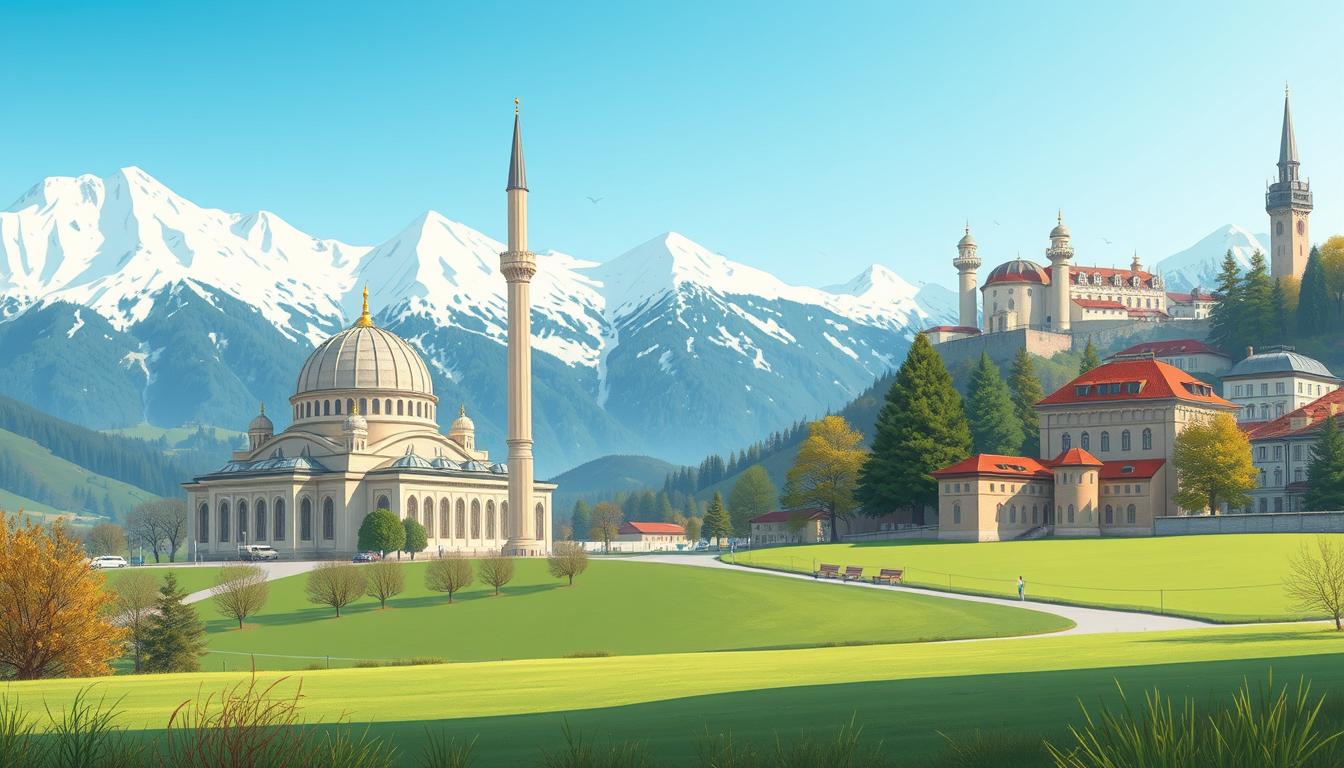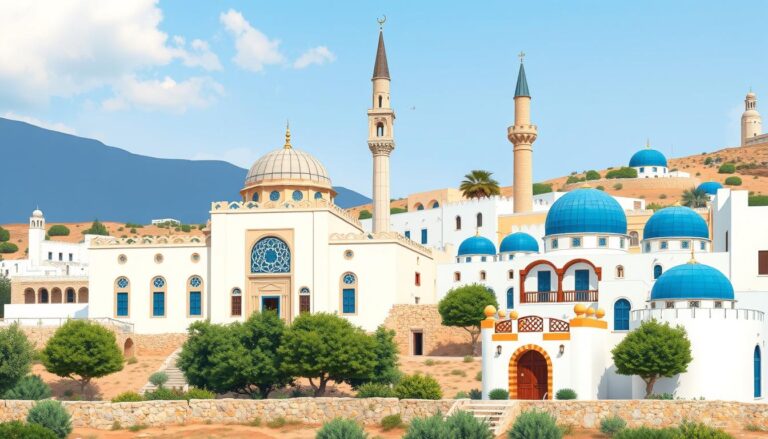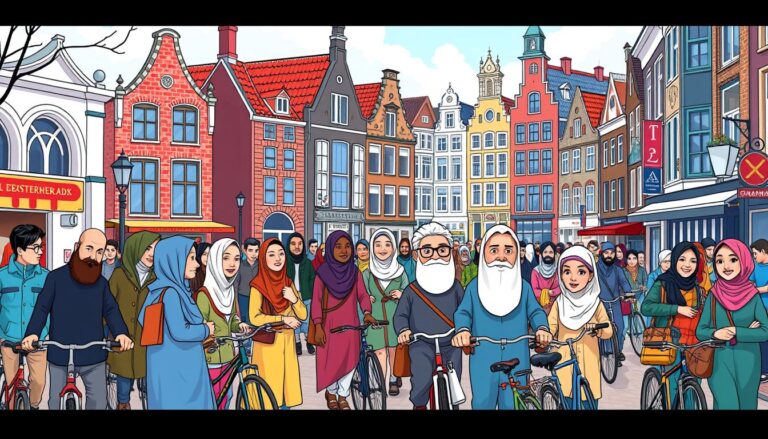Islam in Austria
Did you know that Austria is home to over 620 mosques and Muslim associations? This surprising statistic highlights the significant presence of Islam in the country, which is the largest minority religion, accounting for nearly 7.9% of the total population. The majority of Austria’s Muslim community belongs to the Sunni denomination, with roots tracing back to the 1960s when migrant workers from Turkey and Yugoslavia first arrived in the country. However, the history of Islam in Austria dates much further, with evidence of nomadic Asian tribes entering the region as early as 895 AD, and the country’s involvement in the Ottoman conquest of Hungary in the 16th century and the Austro-Hungarian occupation of Bosnia and Herzegovina in 1878.
Today, Islam plays a vital role in Austrian society, with ongoing debates around integration, legislation, and the cultural impact of this diverse religious community. As the second-largest religious group in the country, the Austrian Muslim population continues to evolve, presenting both challenges and opportunities for the nation’s social and political landscape.
Key Takeaways
- Islam is the largest minority religion in Austria, with nearly 7.9% of the population identifying as Muslim.
- The majority of Austrian Muslims belong to the Sunni denomination and have roots tracing back to the 1960s as migrant workers from Turkey and Yugoslavia.
- The history of Islam in Austria dates back to the 9th century, with the country’s involvement in the Ottoman conquest of Hungary and the Austro-Hungarian occupation of Bosnia and Herzegovina.
- Islam plays a significant role in Austrian society, with ongoing debates around integration, legislation, and the cultural impact of the Muslim community.
- The Austrian Muslim population continues to evolve, presenting both challenges and opportunities for the nation’s social and political landscape.
The Rise of the Muslim Population in Austria
Austria has witnessed a remarkable growth in its Muslim population over the past few decades. In 1971, the Muslim community in Austria numbered around 22,000, but this figure has skyrocketed, reaching an estimated 700,000 in 2016 – a staggering 22% increase since 2012. This demographic shift can be attributed to successive waves of Muslim immigration to Austria.
Muslim Immigration Waves
The first major influx of Muslim migrants to Austria occurred in the 1960s, when the country welcomed migrant workers from Turkey and Yugoslavia. This was followed by a significant increase in the number of Muslim refugees arriving during the Yugoslav Wars in the 1990s. Today, Muslims make up around 7.9% of Austria’s total population, with the majority belonging to the Sunni denomination.
Demographic Data and Statistics
The growth of the Muslim population in Austria is evident in the census data. In 1981, the Muslim population stood at 76,939, which grew to 158,776 by 1991 (+106.4%) and 338,988 by 2001 (+113.5%). By 2012, the number had reached 573,876, a 69.3% increase from 2001. This trend reflects the significant impact of Muslim immigration to Austria and the growth of the Muslim population in the country.
The largest ethnic group among Muslims in Austria is of Turkish descent, followed by Bosnians and Arabs. The western federal state of Vorarlberg has the highest share of Muslims at 8.36%, while Vienna and Salzburg also have notable Muslim populations. The legal status of Muslims in Austria is unique, with the country historically providing religious freedom and legal protections for Islamic communities.
“The significant increase in Muslim population in Austria has been attributed to growing willingness among Muslims to speak publicly about their religion, with a rising trend in conversions to Islam observed in recent years.”
Historical Roots of Islam in Austria
The history of Islam in Austria dates back to the 9th century, with the arrival of nomadic tribes from Asia. Following the Ottoman influence in Austria and the Ottoman conquest of the Medieval kingdom of Hungary in the 16th century, more Muslims moved into the territory that makes up modern-day Austria. While many Muslims were expelled after the Austro-Hungarian Empire took control of the region in the late 17th century, a few were allowed to remain after the signing of the Treaty of Passarowitz in 1718. The largest number of Muslims came under Austrian control after the Austro-Hungarian occupation of Bosnia and Herzegovina in 1878. Over the centuries, the Muslim presence in Austria has ebbed and flowed, shaping the country’s religious and cultural landscape.
The history of Islam in Austria reflects the complex interplay of religious, political, and demographic factors that have shaped the country’s religious diversity. From the arrival of nomadic tribes to the influx of Muslims during the Ottoman and Austro-Hungarian eras, the presence of Islam in Austria has been a significant part of the nation’s history.
“The Muslim presence in Austria has been a part of the country’s social landscape since the 9th century, reflecting the dynamic and evolving nature of the nation’s religious and cultural identity.”
Today, the Muslim population in Austria continues to grow, with nearly half a million Muslims comprising around 6% of the total population. The community’s ethnic and cultural diversity, ranging from Turkish and Bosnian roots to Shia and Sunni traditions, has contributed to the rich tapestry of Austrian society.
The Role of the Islamic Religious Community Organizations
The Islamic religious community in Austria has been organized through various associations and organizations over time. In 1904, Bosnian Muslim students in Vienna established the first Muslim association in Austria, the Islamitisch akademischer Verein „Zvijezda” (Islamite Academic Association “Zvijezda”). In 1907, some of its members split off and formed the second Muslim association in Vienna, the Verein der fortschrittlichen islamitischen akademischen Jugend „Svijest” (Association of Progressive Islamite Academic Youth “Svijest”).
Islamic Religious Community Organizations in Austria
After the Annexation of Bosnia and Herzegovina in 1908, “Svijest” organized an action committee for gaining recognition of Islam in Austria. This led to Austria recognizing Muslims (“of the hanafite rite”) as a religious society and regulating their religious freedoms with the so-called Islamgesetz (Islam Law) in 1912. The Islamische Glaubensgemeinschaft in Österreich (Community of Muslim believers in Austria) was later organized in accordance with the Islamgesetz in 1979.
Today, the Islamic Religious Community in Austria (IGGO) is the umbrella organization representing the Islamic religious community in the country. It plays a significant role in providing Islamic religious education, training Muslim teachers, and advocating for the rights and interests of the Muslim community groups in Austria.
“The IGGO ensures the provision of Islamic religious education in public schools, employing around 600 Muslim teachers to serve over 70,000 Muslim students across Austria.”
Additionally, the Alevi Community of Austria was recognized as the second Islamic community in 2013, with the privilege to provide Alevite religious education in public schools. This demonstrates the diversity and recognition of Islamic organizations in Austria within the country’s educational system.
Prominent Muslim Figures and Leaders
Over the history of Islam in Austria, several influential Muslims have played pivotal roles in shaping the development and representation of the Austrian Muslim community. These prominent figures include Zeki Aly, Mohammed Ali Binni, and Baron Omar Rolf von Ehrenfels, who founded the Islamischer Kulturbund private association in 1932 to organize Muslims in the country.
Salih Hadžialić, an employee of the Croatian embassy in Berlin, was installed as the president of the Islamische Gemeinschaft zu Wien (Islamic Community in Vienna) in 1943 due to political pressure. Anas Schakfeh, who led Austria’s Muslims between 1997 and 2011, maintained good relations with the political leadership and contributed significantly to the integration of influential Muslims in Austria and the Muslim community leaders in Austria.
These prominent Austrian Muslims and others have played a crucial role in shaping the role of Islam in Austrian society over the decades, ensuring the representation and development of the Muslim community leaders in Austria.
“These individuals have helped shape the role of Islam in Austrian society over the decades, ensuring the representation and development of the Muslim community.”
Islam in Austria Legislation and Laws
Austria has a long and complex history of legislation and laws governing the status of Islam and Muslims within the country. The Recognition Act of 1874 laid the foundation by granting legal recognition to Christian and non-Christian religious communities, including Muslims, as Religionsgesellschaften (religious societies).
The Islam Act of 1912
The Islamgesetz (Islam Law) of 1912 formally recognized Muslims (“of the Hanafite rite”) as a religious society and regulated their religious freedoms. This landmark legislation was intended to provide a legal framework for the growing Muslim population in Austria-Hungary at the time.
The New Islam Act of 2015
In 2015, the Austrian parliament passed a new Islamgesetz, which aimed to address the changing landscape of Islam in the country. The updated law prohibited foreign funding of mosques and paying salaries of imams, while also granting Muslims additional rights, such as the rights to halal food and pastoral care in the military. According to the Minister for Foreign Affairs, Sebastian Kurz, the 2015 law was intended to “clearly combat” the influence of Islamic extremism in Austria.
The legislation on Islam in Austria and the laws regulating Muslims in Austria have undergone significant changes over the past century, reflecting the evolving Austrian Islam Act and the changes to Muslim legal status in Austria. These legislative efforts have aimed to balance the recognition of Islam as a major religion in the country with concerns over security and integration.
Integrating Islam into Austrian Society
The integration of Islam into Austrian society has faced various challenges and controversies over the years. In 2017, the Austrian government passed a law banning the covering of the face in public, which was criticized by many as Islamophobic and discriminating against Muslim women who wear religious face veils. The law was upheld by the European Court of Human Rights, despite protests from opponents such as President Alexander Van der Bellen and experts like Farid Hafez.
In 2018, the Austrian government announced the closure of seven mosques and the deportation of 40 imams paid by Turkey, citing concerns about “political Islam,” Islamism, and radicalization. These types of measures have raised concerns about the marginalization of the Muslim community and the erosion of religious freedoms in Austria.
Challenges and Controversies
The integration of Islam in Austria has faced several challenges and controversies, including:
- The 2017 law banning the covering of the face in public, which was criticized as Islamophobic and discriminatory against Muslim women
- The 2018 closure of seven mosques and the deportation of 40 imams paid by Turkey, citing concerns about “political Islam,” Islamism, and radicalization
- Concerns about the marginalization of the Muslim community and the erosion of religious freedoms in Austria
“These types of measures have raised concerns about the marginalization of the Muslim community and the erosion of religious freedoms in Austria.”
Despite these challenges, the Muslim population in Austria has continued to grow, with the number of Muslims in the country reported to be over 550,000 as of 2012, representing approximately 7% of the population. The integration of Islam into Austrian society remains an ongoing and complex process, with both progress and setbacks along the way.
“Islam in Austria”: Muslim Population Percentage
Islam has a significant presence in Austria, with the religion accounting for a growing percentage of the country’s population. According to the Austrian Academy of Sciences, as of 2016, Islam was practiced by 7.9% of the total population in Austria. This makes it the largest minority religion in the country.
The Muslim population in Austria has witnessed a substantial increase over the past few decades. From around 22,000 adherents in 1971, the Muslim community has grown to an estimated 700,000 individuals in 2016. The majority of Muslims in Austria belong to the Sunni denomination, with additional communities of Shia, Alevi, and other Muslim groups also present.
The rise in the percentage of Muslims in Austria can be attributed to several factors, including immigration from predominantly Muslim countries, higher birth rates among the Muslim population, and the conversion of individuals to Islam. This demographic shift has sparked discussions and debates around the integration of the Muslim community into Austrian society.
“The Muslim minority numbers half a million, which is about 6 percent of the population.”
While the percentage of Muslims in Austria remains relatively low compared to other European countries, the growth of the Muslim population has raised concerns and questions about the challenges and opportunities associated with the integration of this diverse religious community into the broader social fabric of the nation.
As Austria continues to navigate the complexities of its evolving religious landscape, the role and influence of the Muslim population will undoubtedly continue to be a topic of ongoing discourse and policymaking within the country.
Political Discourse on Islam in Austria
The political debate around Islam in Austria has been heavily influenced by the rise of the far-right Austrian Freedom Party (FPÖ). Under the leadership of Jörg Haider in the 1990s, the party shifted its focus to anti-immigration and anti-Muslim rhetoric, portraying Muslims as a threat to Austrian culture and identity.
The FPÖ’s strategy continued under Heinz-Christian Strache, who frequently used slogans like “Vienna must not become Istanbul” and called for the defense of the “Christian Occident” against Islamic influence. The party’s anti-Muslim campaigns have played a significant role in shaping the political landscape and public discourse on Islam in Austria.
The Freedom Party’s Rhetoric
The FPÖ’s anti-Muslim rhetoric has had a significant impact on political debates on Islam in Austria. In the 1986 and 1990 elections, the party attracted nearly twice as many male voters as female voters, and it performed best among 19 to 29-year-olds. The party’s vote share increased from 4.9% to 9.3% in the first election campaign under Jörg Haider’s leadership in 1986, and it nearly doubled its vote share from 5% to 26.9% in parliamentary elections from 1983 to 1999.
The FPÖ’s far-right messages gained further validation when the party secured 17.54% of the votes in the 2008 national elections. In Vienna, the party doubled its vote share from 10.9% to 25.8% in 2008 by running on an anti-immigration and anti-Muslim platform.
“Vienna must not become Istanbul” – FPÖ campaign slogan, 2005
The FPÖ’s anti-Muslim rhetoric has been echoed by other political parties, such as the Austrian People’s Party (ÖVP), which has framed ‘political Islam’ as a threat to Austrian society, arguing that it is a combination of religious fundamentalism and political extremism that serves as a breeding ground for violence and terrorism.
Cultural Impact of Islam in Austria
Islam has left an indelible mark on the cultural fabric of Austria, contributing to the country’s rich diversity. Over the centuries, the presence of thriving Muslim communities has influenced various aspects of Austrian society, from architecture and art to cuisine and traditions.
The construction of mosques and Islamic centers has become a visible symbol of the Muslim community’s integration and participation in Austrian life. These structures, often adorned with intricate designs and calligraphy, not only serve as places of worship but also showcase the influence of Islam on Austrian culture.
Beyond the physical landscape, Muslim cultural contributions in Austria can be seen in the culinary realm. The introduction of spices, ingredients, and cooking techniques from the Islamic world has enriched the Austrian gastronomic landscape, with staple dishes like Baklava and Kebabs becoming beloved parts of the national cuisine.
The role of Islam in Austria’s diversity extends to the realm of art and literature. Islamic-inspired motifs and patterns have found their way into Austrian art, while the works of renowned Muslim artists and intellectuals have gained recognition and appreciation within the country.
While the integration of Islam into Austrian society has faced its share of challenges, the cultural exchange and interplay between Islamic and Austrian traditions have ultimately enriched the country’s cultural fabric, fostering a more pluralistic and inclusive society.
“The presence of Islam in Austria has not only contributed to the country’s religious diversity but has also left an indelible mark on its cultural heritage.”
Mosques and Islamic Centers in Austria
Austria is home to a diverse array of mosques and Islamic centers that serve the country’s thriving Muslim population. These religious institutions play a vital role in the lives of Austrian Muslims, providing spaces for worship, community gatherings, and the preservation of Islamic traditions.
One of the most prominent mosques in Austria is the King Fahd Mosque in Vienna, known for its striking architectural design featuring a 32-meter high dome and a prominent two-toned color scheme. Another notable mosque is the Suleiman Mosque in Graz, which attracts a large following within the local Muslim community.
The Masjid-As-Salam Wapena Mosque, located near the Wien Miedling train station, is another significant Islamic center in Austria, despite its relatively simple appearance. These mosques and others like them serve as hubs for the Muslim community, facilitating religious and cultural activities that contribute to the diversity and pluralism of the Austrian landscape.
Austria’s Muslim population, estimated to be around 340,000, or 7.8% of the total population, with a significant concentration in the capital city of Vienna. The country’s Muslim community is composed of diverse ethnic backgrounds, including Turkish (approximately 120,000) and Bosnian (around 50,000) Muslims.
The presence of mosques and Islamic centers in Austria reflects the country’s long-standing history with Islam. The first mosque in Vienna was established in 1878, catering to Bosnian Muslims supporting the Austrian army. Over the years, Austria has witnessed waves of Muslim immigration, particularly in the post-World War II era and during the economic booms of the 1970s, as well as the disintegration of Yugoslavia in the early 1990s.
While integration challenges have arisen, particularly in the aftermath of 9/11, the mosques and Islamic centers in Austria continue to serve as important hubs for the Muslim community, promoting cultural exchange and contributing to the country’s rich diversity.
Conclusion
Islam has a long and complex history in Austria, dating back centuries to the arrival of nomadic tribes and the influence of the Ottoman Empire. Over time, the Muslim population has grown significantly, making Islam the largest minority religion in the country today. The integration of Islam into Austrian society has faced challenges and controversies, particularly in recent decades as the populist far-right Freedom Party has risen to prominence with its anti-Muslim rhetoric.
Despite these challenges, Islam has left a lasting cultural impact on Austria, contributing to the country’s religious diversity and enriching its social fabric. Research indicates a distinctive form of “open religiosity” among younger Muslims in Austria, characterized by a more individualistic and self-determined approach to religious practices. This suggests a shifting dynamic in the way Islam is embraced and expressed by successive generations of Muslims in the country.
As Austria continues to navigate the role of Islam within its society, the ongoing dialogue and policy debates will shape the future of this dynamic relationship. The summary of the key takeaways on the role of Islam in Austria highlights the need for a nuanced understanding of the complex interplay between religious, social, and political factors. Ultimately, the integration and acceptance of Islam within the Austrian context will be crucial in fostering a more inclusive and harmonious society.
Source Links
- Why is Austria coming after the Muslim Brotherhood?
- The Austrian state’s attack on Muslims shows no sign of easing
- Politicizing Islam in Austria – Rutgers University Press
- Islam in Austria –
- Islam and Muslim Minorities in Austria: Historical Context and Current Challenges of Integration – Journal of International Migration and Integration
- Islam in Austria – ProQuest
- Austria’s Muslims fear changes to historic Islam law
- Islamic Religious Education in Contemporary Austrian Society: Muslim Teachers Dealing with Controversial Contemporary Topics
- Austria – United States Department of State
- Austria – United States Department of State
- Austria’s new law on ‘political Islam’ opens door for crackdown on Muslims
- Austria’s Freedom Party: Islam and the New Right
- The Islam Law of 1912: an example of the integrative effect of the multi-ethnic empire
- Opinion | Austria’s Islamic Reforms (Published 2015)
- Reforms to Austria’s Islam law seek to prevent ‘parallel society’
- Religion in Austria
- Islam and Dialogue in Austria — New Austrian
- In Vienna, a bid to foster ‘Islam of the Austrian kind’
- Surveilling and Criminalizing Austrian Muslims: The Case of ‘Political Islam’
- Islam in Austria
- Islam in Austria-Hungary / 1.0 / encyclopedic – 1914-1918-Online (WW1) Encyclopedia
- Austria – United States Department of State
- Visit These Beautiful Mosques In Austria To Understand Its History And Heritage
- How Prominent Muslims in Austria Were Painted as Enemies of the State
- A Visit to Muslims in Austria: Vienna and Vorarlberg – The LADO Group
- Muslim Everyday Religious Practices in Austria. From Defensive to Open Religiosity







